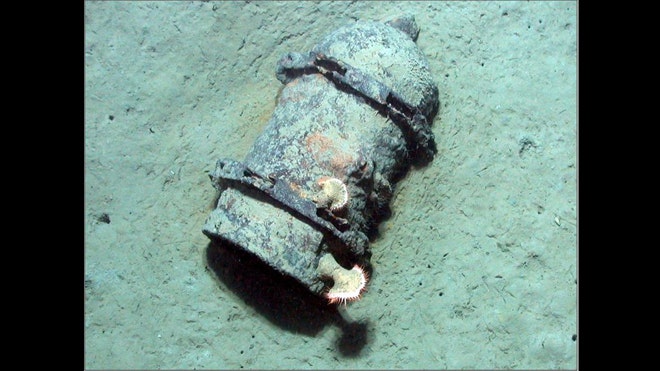
Lurking (and leaking) beneath the world's oceans are an estimated 200 million pounds of unexploded and potentially dangerous explosives -- from bombs to missiles to mustard gas.
Texas A&M oceanographers William Bryant and Niall Slowey documented two such dumpsites in the Gulf of Mexico recently. They conservatively guess that at least 31 million pounds of bombs can be found not just in the Gulf, but also off the coasts of at least 16 states, from New Jersey to Hawaii.
Thousands of gallon containers of mustard gas lie strewn off the New Jersey coast, for example. And there are a total of seven dumpsites on the Gulf seafloor, each approximately 81 square miles, one at the mouth of the Mississippi River Delta.
“The amount that has been dumped was unbelievable,” Bryant said. “No one seems to have reported seeing explosives in the Gulf. We felt it was our responsibility to report it.”
The existence of unexploded ordnance (UXO) is hardly a secret, they acknowledge: Sea disposal of munitions was an accepted international practice until quite recently. Dumping conventional and chemical munitions captured from enemies -- from Nazi Germany, for example -- was also an accepted practice.
In 1970 the Department of Defense prohibited the practice, and Congress followed up by passing the Marine Protection, Research, and Sanctuaries Act in 1972, generally banning sea disposal.
But after half a century or more on the sea floor, the condition of the munitions is a dangerous unknown.
“Is there an environmental risk? We don’t know, and that in itself is reason to worry,” Bryant said. “We just don’t know much at all about these bombs, and it’s been 40 to 60 years that they’ve been down there.”
Suspicions have long circulated that undocumented munitions have been “short-dumped” -- as in dumped long before reaching their designated site, leaving them far closer to the coast than believed by authorities.
While conducting marine geology research on the sea floor of the Gulf, Bryant’s team came across the two dumpsites and vividly captured decaying canisters they believe most likely contain chemical weapons.
They presented their research at the International Dialogue on Underwater Munitions in Puerto Rico recently.
They also found themselves floating in a field of munitions as large as 500 pounds.
According to a statement published by Texas A&M University, an explosion from UXO could threaten ship traffic, commercial fishing, cruise lines and other activities, as well as the approximately 30,000 people working on the oil and gas rigs and marine life in the Gulf.
The team said Texas is closest to the bombs they have seen, which lie as near as 50 miles offshore. Louisiana was the second closest, particularly the Mississippi River Delta.
So what exactly is down there -- and is it still as lethal as the day it was created?
The Defense Department began a massive research effort in 2004, thousands of hours of labor spent reviewing several million pages of documentation, to get a grip on the location, type and quantity of weapons in the water.
While this project initially focused on chemical warfare material, it shifted to locating conventional munitions and considering where ranges and coastal artillery batteries could have deposition munitions.
Oceanographers and other experts believe no one knows for certain just what’s offshore, hence Prof. Bryant’s efforts to raise awareness about the Gulf of Mexico sites.
Sea-disposed munitions that aren’t fused or armed are called discarded military munitions (DMM). UXO have undergone the arming sequence but failed to function as intended, so are often designated the most dangerous of DMM.
There are two potential risks associated with these and any underwater munitions: immediate detonation or exposure to toxic chemical agents and long-term prolonged exposure.
Recovery from the world’s waters, either by destroying them in place or lifting them from the water, can be more dangerous than leaving them as is, however. Bryant’s work reveals that many underwater munitions have deteriorated over time and exposure.
Yet proximity to shore means they’re hardly hidden.
Reports of Louisiana shrimpers pulling up hissing barrels in their nets have led to suspicions that the shrimpers are exposing themselves to mustard gas. The incidents haven’t been confirmed as chemical weapons, but Bryant said he “can’t imagine what else would have been dumped in those canisters and begun to hiss.”
American shrimpers finding mustard gas drums in their fishing nets -- what will they find next?
No comments:
Post a Comment